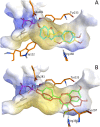Structural basis for non-genuine phenolic acceptor substrate specificity of Streptomyces roseochromogenes prenyltransferase CloQ from the ABBA/PT-barrel superfamily
- PMID: 28355308
- PMCID: PMC5371340
- DOI: 10.1371/journal.pone.0174665
Structural basis for non-genuine phenolic acceptor substrate specificity of Streptomyces roseochromogenes prenyltransferase CloQ from the ABBA/PT-barrel superfamily
Abstract
Acceptor substrate specificity of Streptomyces roseochromogenes prenyltransferase SrCloQ was investigated using different non-genuine phenolic compounds. RP-UHPLC-UV-MSn was used for the tentative annotation and quantification of the prenylated products. Flavonoids, isoflavonoids and stilbenoids with different types of substitution were prenylated by SrCloQ, although with less efficiency than the genuine substrate 4-hydroxyphenylpyruvate. The isoflavan equol, followed by the flavone 7,4'-dihydroxyflavone, were the best non-genuine acceptor substrates. B-ring C-prenylation was in general preferred over A-ring C-prenylation (ratio 5:1). Docking studies of non-genuine acceptor substrates with the B-ring oriented towards the donor substrate dimethylallyl pyrophosphate, showed that the carbonyl group of the C-ring was able to make stabilizing interactions with the residue Arg160, which might determine the preference observed for B-ring prenylation. No reaction products were formed when the acceptor substrate had no phenolic hydroxyl groups. This preference can be explained by the essential hydrogen bond needed between a phenolic hydroxyl group and the residue Glu281. Acceptor substrates with an additional hydroxyl group at the C3' position (B-ring), were mainly O3'-prenylated (> 80% of the reaction products). This can be explained by the proximity of the C3' hydroxyl group to the donor substrate at the catalytic site. Flavones were preferred over isoflavones by SrCloQ. Docking studies suggested that the orientation of the B-ring and of the phenolic hydroxyl group at position C7 (A-ring) of flavones towards the residue Tyr233 plays an important role in this observed preference. Finally, the insights obtained on acceptor substrate specificity and regioselectivity for SrCloQ were extended to other prenyltransferases from the CloQ/NhpB family.
Conflict of interest statement
Figures






Similar articles
-
Structure and mechanism of the magnesium-independent aromatic prenyltransferase CloQ from the clorobiocin biosynthetic pathway.J Mol Biol. 2010 Dec 10;404(4):611-26. doi: 10.1016/j.jmb.2010.09.067. Epub 2010 Oct 12. J Mol Biol. 2010. PMID: 20946900
-
Mechanistic insights into Mg2+-independent prenylation by CloQ from classical molecular mechanics and hybrid quantum mechanics/molecular mechanics molecular dynamics simulations.Biochemistry. 2014 Aug 5;53(30):5034-41. doi: 10.1021/bi500531p. Epub 2014 Jul 25. Biochemistry. 2014. PMID: 25020142
-
CloQ, a prenyltransferase involved in clorobiocin biosynthesis.Proc Natl Acad Sci U S A. 2003 Mar 4;100(5):2316-21. doi: 10.1073/pnas.0337708100. Proc Natl Acad Sci U S A. 2003. PMID: 12618544 Free PMC article.
-
Prenyl transfer to aromatic substrates in the biosynthesis of aminocoumarins, meroterpenoids and phenazines: the ABBA prenyltransferase family.Phytochemistry. 2009 Oct-Nov;70(15-16):1728-38. doi: 10.1016/j.phytochem.2009.05.009. Epub 2009 Jun 24. Phytochemistry. 2009. PMID: 19559450 Review.
-
[Biosynthesis of a hybrid terpenoid polyketide-derived natural product and production of useful prenylated compounds by using prenyltransferase].Tanpakushitsu Kakusan Koso. 2007 Oct;52(13 Suppl):1736-41. Tanpakushitsu Kakusan Koso. 2007. PMID: 18051409 Review. Japanese. No abstract available.
Cited by
-
Synthetic biology, combinatorial biosynthesis, and chemo‑enzymatic synthesis of isoprenoids.J Ind Microbiol Biotechnol. 2020 Oct;47(9-10):675-702. doi: 10.1007/s10295-020-02306-3. Epub 2020 Sep 3. J Ind Microbiol Biotechnol. 2020. PMID: 32880770 Free PMC article. Review.
-
Heterologous Biosynthesis of Prenylflavonoids in Escherichia coli Based on Fungus Screening of Prenyltransferases.ACS Omega. 2025 Mar 2;10(9):8891-8900. doi: 10.1021/acsomega.4c05007. eCollection 2025 Mar 11. ACS Omega. 2025. PMID: 40092771 Free PMC article.
-
Prenylation of Flavanones by an Aromatic Prenyltransferase from Fusarium globosum.Molecules. 2025 Mar 31;30(7):1558. doi: 10.3390/molecules30071558. Molecules. 2025. PMID: 40286157 Free PMC article.
-
Enzymatic studies on aromatic prenyltransferases.J Nat Med. 2020 Jun;74(3):501-512. doi: 10.1007/s11418-020-01393-x. Epub 2020 Mar 17. J Nat Med. 2020. PMID: 32180104 Free PMC article. Review.
-
Acceptor substrate determines donor specificity of an aromatic prenyltransferase: expanding the biocatalytic potential of NphB.Appl Microbiol Biotechnol. 2020 May;104(10):4383-4395. doi: 10.1007/s00253-020-10529-8. Epub 2020 Mar 18. Appl Microbiol Biotechnol. 2020. PMID: 32189045 Free PMC article.
References
-
- Liang PH, Ko TP, Wang AHJ. Structure, mechanism and function of prenyltransferases. Eur J Biochem. 2002;269(14):3339–54. - PubMed
MeSH terms
Substances
LinkOut - more resources
Full Text Sources
Other Literature Sources
Research Materials
Miscellaneous

